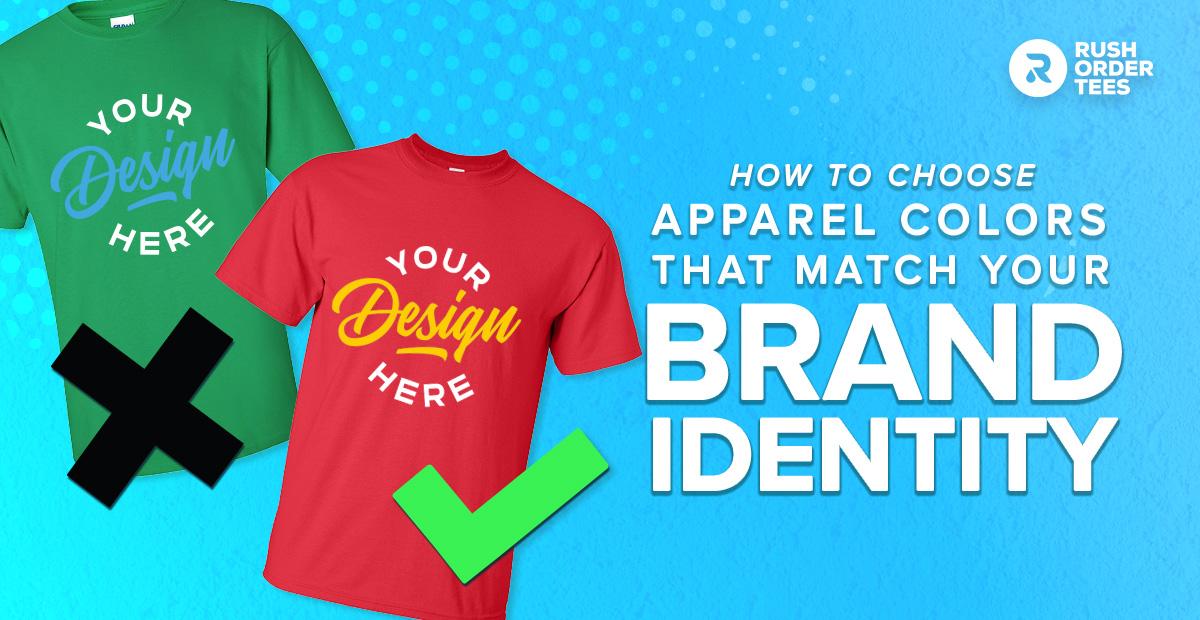

If you’re like most people — or maybe just like me — you probably see specific colors when you think of major brands. For example: BMW (blue and white), Target (red), Whole Foods (green), McDonald’s (gold and red)... you get the idea.
When it comes to branding, a color is never just a color. Color choices should be intentional, positioning the brand in strategic ways that incorporate core elements of consumer psychology and broader cultural associations. That extends to your custom promotional apparel.
Here’s how to pick the right colors that align with and complement your established branding so you can promote recognition and loyalty.
Why Apparel Colors Are Key to Your Brand Identity
Apparel colors are important for myriad reasons. In terms of supporting a strong brand identity, here are some of the most essential ones.
- Visual Recognition: Before people recognize a logo or slogan, they see colors. Intentional color choices can immediately stand in for your brand, even without other branding elements.
- Emotional Impact: Colors can naturally convey emotions, even with no other context, which can help you align your brand with the specific feelings you want your audience to associate with it.
- Uniqueness: The right apparel color choices and combinations can help your brand stick out in a crowded marketplace.
- Value Communication: Your apparel colors tell a story about your brand. The right tones, combinations, and applications can tell people what kinds of qualities to expect from your brand.
- Trend Capitalization: By aligning color choices with consumer trends, you can increase apparel sales based on the hues that are currently in vogue. This is even useful for free items like corporate gifts, as the right colors encourage people to wear your apparel more, maximizing promotional opportunities.
The Role of Colors in Communicating Brand Personality
Colors help communicate your brand's personality by triggering emotions, shaping perceptions, and leveraging common associations with those colors. A brand’s color palette acts as a visual shorthand for its character, values, and essence, showing potential consumers some sense of the brand’s product or service without having to know anything specific about it.
For example, vibrant colors like red and yellow communicate a sense of urgency, energy, creativity, and lightheartedness — the perfect cocktail of emotions to make a kid plead for their parents to U-turn back to the McDonald’s they just passed. Meanwhile, muted tones like grays, whites, and blacks show more formal senses of quality, sophistication, authority, and seriousness (see: “millennial gray”).
This isn’t to say that every color says the same exact thing 100% of the time to every single viewer — rather, it’s to say that colors come with common associations you can use to your brand’s advantage. It’s also possible to subvert expectations by picking colors that otherwise oppose your brand positioning.
Aligning Colors With Your Audience
Keeping colors aligned with your brand’s unique values is a tough enough task even without considering that you’ll need to keep your colors aligned with your audience, too.
Just like colors help promote brand identity, they communicate your values with your audience. Obviously (or maybe not so obviously for everyone) this process is more effective if you start with a firm understanding of your audience and their preferences and expectations.
Before assigning colors to your apparel, perform a detailed audit of your audience so you know exactly who it is you want to wear those branded t-shirts — and what it is you want to communicate to them about your brand. For example, formal office-goers may prefer more conservative tones for custom business apparel, while younger pre-professionals might gravitate toward bold color pops. If your audience includes outdoorsy types, earth tones in custom activewear could be the perfect fit.
Once you establish the demographics, interests, and style comps for your core audience, find the intersection between their sensibilities and your company’s values to find the colors that bridge between the two.
Matching Apparel Colors to Your Existing Brand Palette
It may go without saying for some, but it’s important enough to point out just in case that matching apparel colors to your existing palette is absolutely essential. This keeps your branding cohesive across products while strengthening brand identity overall, which also promotes brand trust and a general sense of legitimacy.
You’ve already done the preliminary work of establishing strong colors and a well-defined brand color palette, so extend them to your promotional branded apparel as well. When people see said apparel, they should have a clear mental link back to your brand. For example, let’s say you’re a soft drink company with a distinctive red, white, and blue logo. You’ll want to incorporate combinations of those specific shades in your branded apparel — in this case, red #FF1400, white #FFFFFF, and blue #0E0E96.
Look to your primary, secondary, and accent colors, and then apply their specific codes to your custom designs. It’s worthwhile to print samples or swatches first to ensure they look the same when printed in real life as they do in your digital color library.
Choosing the Right Color Combinations for Impact
At the end of the day, the most important thing is that your apparel leaves a lasting impression that directly conjures your brand. The right combinations can draw attention to key design elements you want to emphasize and use to convey your brand's personality. Poorly chosen colors, on the other hand, can confuse viewers by drawing the eye to multiple places, reducing readability, or — maybe worst of all — repelling them entirely.
As with a primary color, color combinations should ideally draw from your brand color palette. Since this palette should have already been approved for cohesion, you should be safe to combine colors from here. But if visual elements aren’t your forte, this is where designers come in handy. They can lean on color theory to pull the right colors that communicate the emotions you need while staying on-brand.
Practical Tips for Testing and Refining Color Choices
To make sure your colors resonate with the audience you think they do the way you want them to, it’s important to test, refine, and retest them. Here are a few of our favorite ways to do that.
- Try Varying Formats: Be sure to test your design out in multiple product formats, even ones you don’t necessarily plan on using right now. Seeing how the colors look in varying formats, on multiple products, and with different printing methods can help you make the right choice.
- Analyze Competitors: Study your industry competitors so you can avoid using similar palettes, differentiating your colors in a crowded landscape.
- Check for Accessibility: Ensure text and design elements meet accessibility standards using contrast checker tools for readability.
- Gather Real Feedback: Focus groups are ideal, but informal feedback from colleagues and loyal customers can be just as valuable. Honest opinions can help you refine your designs to create the most impactful apparel possible.
- Incorporate Feedback: Refine colors based on test results and audience input so you can adjust tones, shades, or saturation as needed.
Stand Out While Staying True to Your Industry
By choosing a custom color palette that’s tailored to your brand and creates a visual identity that’s distinct from your competitors, you can make your brand more memorable and recognizable without alienating your market. For example, different industries tend to operate within similar palettes — consider how banks and financial businesses in the U.S. tend to pick from some combination of red, white, and blue to signal trustworthiness.
However, that doesn’t mean you need to totally follow your industry’s trends — on the contrary, it can help your marketing efforts to stand out. By outright opposing traditional industry colors or even looking to proprietary shades, you can make your brand stand out in the crowd. This might be more directly related to establishing general branding rather than apparel colors, but the same applies — particularly if you’re trying to compete in crowded spaces. Sticking out visually with distinctive tradeshow giveaways, for example, can be a big benefit.
Pick the Right Branded Apparel Colors to Reflect Your Brand
Remember, apparel colors tell people a lot about your brand in an instant. We all have associations with colors that, while not always the same for everyone, can be pretty consistent on the whole.
Marketing is a game of probability. The right colors make your products more likely to get worn, be seen, and be remembered. To round up the tactics above, you can do that through:
- - Keeping your colors on the same page as your audience
- - Ensuring your colors are consistent with your brand palette
- - Picking impactful combinations
- - Testing your designs across formats
- - Getting feedback on your designs
It’s impossible to separate your brand’s identity from your colors — each informs the other. Once you’ve made the color choices that balance representing your brand with appealing to your audience while aligning with your industry and standing out (no small feat), RushOrderTees can ensure your custom apparel and promotional products are printed and delivered when and where you need them.

About the Author
Based in New Mexico, Bryce Emley is a seasoned content writer and expert in the realms of custom apparel and eCommerce. Holding an MFA in Creative Writing, he seamlessly blends his passions, specializing in insightful content that bridges the gap between innovative apparel solutions and digital commerce trends. Beyond his professional pursuits, Bryce is an avid creator, channeling his creativity into poetry, screenplays, and creative nonfiction. In his leisure time, he has a penchant for collecting unique, vintage anime t-shirts, showcasing his love for both rare finds and the artistry of apparel design.
